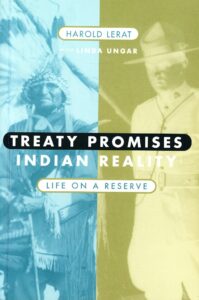Book review: Treaty Promises: Indian Reality – Life on a Reserve
 Reviewed by Karl Hele
Reviewed by Karl Hele
Treaty Promises: Indian Reality – Life on a Reserve is a story of Harold LeRat, his ancestors, and Cowessess First Nation’s experience from the 1870s to approximately the 1960s. While the story is LeRat’s, the book itself was written by Linda Ungar. Ungar also undertook archival research to fill in details, complement, and illustrate settler opinions and actions. By working closely together and following LeRat’s narrative, Ungar and LeRat have created an interesting and illuminating history.
By blending oral history, personal experience, and written records, Treaty Promises deftly shows the resilience of a family and community in the face of settler colonialisms. For instance, oral histories of successful farming are supported by archival records that are used to show the duplicity of Indian Agents, priests, and local settlers claiming that the Indians were not farming or utilizing the lands fully. Simply, the petitions and actions to secure a land surrender were fictions or ‘alternative facts’ born of a desire to have Indian land regardless of First Nation’s use thereof. Additionally, the book itself shows the overall failure of the government to adhere to treaty and treaty promises while the people of Cowessess worked hard to make lives for themselves and the coming generations. LeRat shows this by discussing the forced movement of his ancestors from Cypress Hills to what becomes the Cowessess reserve, as well as his family and personal life on the reserve, farming, Indian Act strictures, residential schooling, and recreation.
The power of the Indian Act and its agents is readily apparent, yet LeRat and many in the community were able to make a living, enjoy life, and ‘get around’ the rules. For LeRat, the real end of independence for the community was the introduction of welfare policies rather than Indian Act strictures or other colonial policies – it undercut the need to work to survive. Regardless of LeRat’s lament surrounding welfare, by focussing on the Indian Reality through Life on a Reserve, Treaty Promises shows pride in community, its people, and the sheer strength of will to adapt and thrive in a radically changed world. This is the most important, yet subtle, aspect of the book. Despite colonialism, racism, and oppression, LeRat, his ancestors, and the people of Cowessess from the 1870s onward, proved to be resilient, thereby ensuring their survivance as a people and community into the present. While the majority of Treaty Promises follows the history from the 1870s to the 1960s, the final chapter does offer a few tidbits that extend into the 1990s.
LeRat’s story, Treaty Promises: Indian Reality – Life on a Reserve, is a wonderful tale of survivance and resilience as well as a restorying of a personal and community history. It is a down-to-earth narrative, that while occasionally told in a non-linear manner, is easy to follow, uplifting, educational, and forward-thinking. It is a book worth reading, particularly for students and others trying to figure out how to tell an Indigenous story in an authentic manner that speaks to the reader rather than a dense philosophical tract destined to gather dust in on the back shelves in a university library. In short, Treaty Promises is a straightforward, engaging, and educational read for anyone.
Harold LeRat, Treaty Promises: Indian Reality – Life on a Reserve. Saskatoon: Purich Publishing, 2005.


